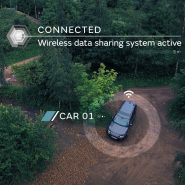British automaker Jaguar Land Rover is one-upping competitors’ attempts for an autonomous vehicle.
The automaker has demonstrated in videos a number of technologies that will pave the way for a vehicle that can drive itself on all terrains, not simply on roads. As autonomous vehicles are met with both excitement and skepticism, illustrating the mechanics and offering a point of differentiation will help the company retain its fans.
“Our autonomous all-terrain driving project is part of our autonomous and intelligent vehicle development program,” said Nathan Hoyt, national product communications manager at Jaguar Land Rover. “The aim to make the self-driving car viable in the widest range of real life, on- and off-road driving environments and weather conditions. This will help both the driven and autonomous car make their way safely through any terrain or driving situation.
“We don’t want to limit future highly automated and fully autonomous technologies to tarmac,” he said. “When the driver turns off the road, we want this support and assistance to continue.
“In the future, if you enjoy the benefits of autonomous lane keeping on a motorway at the start of your journey, we want to ensure you can use this all the way to your destination, even if this is via a rough track or gravel road.”
Off-road, off-wheel
While automakers developing autonomous technology are no longer anomalous, all or most are concentrating on allowing the vehicles to navigate roads. Jaguar Land Rover is associated with off-roading and all-terrain capabilities by name, making the autonomous all-terrain driving research project a necessary point of departure.
Each technological advancement is demonstrated in a separate video.
Views in 360-degrees and sensors will be able to detect the width of a tire, even in rain or snow, and use the information to plan the safest and most efficient route. A stereo camera will also offer overhead clearance assistance to ensure the height of the vehicle, including roof racks or bicycles, will sufficiently clear tunnels and other potential hazards.
A brief video shows a Range Rover Sport driving, depicting the sight lines of the camera from outside, then showing how the detection is signaled from the interior. As the vehicle moves from a paved road to dirt, a close-up of the tire shows the adjustment being made.
Land Rover Range Rover Sport – Surface ID Research Technology
Ultrasonic sensors will look five meters out in front of the car to identify grass, gravel, sand, potholes, snow and water, adjusting speed and performance as necessary. In the aftermath of an autopilot-activated Tesla’s fatal crash (see story), terrain-recognition and adaptation can mitigate scrutiny surrounding the safety.
Another video shows the vehicle driving down a gravel hill, through a shallow river and then up the gravel hill again. As it approaches different terrains and slopes, the speedometer is seen changing without assistance from the driver.
Range Rover Sport – Terrain-Based Speed Adaption Research
Additionally, the all-terrain autonomous vehicles will be able to communicate with one another, ensuring that vehicles are not blind to others that are out of sight, around a curve or behind an off-road obstacle.
This connected convoy capability is also demonstrated in a video showing two vehicles separated by thick foliage. Shots of the interior of the vehicle show radar that relays information about where the other vehicle is and when it has stopped.
Land Rover Off-Road Connected Convoy Research
The videos give consumers a visualization of the technology, helping to sell its efficiency and effectiveness to alleviate safety concerns or other causes of skepticism. Additionally, the videos are short, making them more likely to be shared on social media and, as a result, to reach more users.
Autonomous autorace
As self-driving cars appear on the horizon, brands are fine-tuning the experience to assuage consumers’ more specific worries.
For example, German automaker Audi is continuing to pave the way for piloted vehicles with its latest A7 developments.
The piloted Audi A7 concept has been tested alongside other road users and now is capable of adaptive driving, creating a more human driving resemblance. Autonomous vehicles are now publicly visible and tangibly close to availability, meaning that the details of piloted driving are now the target of the spotlight (see story).
The timeline for such vehicles is still difficult to pinpoint, but recent developments suggest they may be closer than many consumers realize.
German automaker BMW Group is looking to put street-ready autonomous vehicles into production by 2021 with the creation of an open platform with technology partners.
BMW Group, along with collaborators Intel and Mobileye, sees the potential autonomous cars hold to make driving safer and easier, with implications for highway driving as well as ridesharing in denser city streets. While many automakers and consumers still see sophisticated self-driving vehicles as a distant dream, BMW is aiming to make them a reality sooner rather than later (see story).
Jaguar Land Rover has also shared ambitious autonomy goals.
“We are real-world testing a range of autonomous and semi- autonomous technologies,” Mr. Hoyt said. “We expect a degree of autonomy to launch in 2019 and, like our competitors, a Jaguar Land Rover Intelligent vehicle will become a reality within the next 10 years.
“Drivers are already using increasingly automated technologies – like adaptive cruise control,” he said. “They are also benefiting from safer driving technologies like autonomous emergency braking.
“Our mission is to emphasize the potential benefits including the potential for fewer accidents, better traffic flow and less pollution. Any new technology would only be launched by Jaguar Land Rover when it has been fully tested, is robust and offers real benefits.”
from
http://redirect.viglink.com?u=http%3A%2F%2Fredirect.viglink.com%2F%3Fu%3Dhttps%253A%252F%252Fwww.luxurydaily.com%252Fjaguar-land-rover-details-all-terrain-autonomous-driving-project%252F%26key%3Dddaed8f51db7bb1330a6f6de768a69b8&key=ddaed8f51db7bb1330a6f6de768a69b8

No comments:
Post a Comment